Opponents to housing in Chapel Hill often say that they’re not against more housing, they’re just against a particular development or type of housing because of its location and/or because it won’t solve our affordable housing crisis. (This has, in practice, meant that they’ve largely and vocally been against every opportunity to add new housing in the last eight years.)
If you look around, you’ll find that the arguments made against more housing in Chapel Hill and Carrboro are the exact same ones used in places like Berkeley, Palo Alto, Brookline, Austin, Arlington, Bloomington, Ann Arbor, and Portland.
They’re so similar that economist Noah Smith recently wrote up a playbook to “arguments that are easy to deploy in opposition to nearly any proposed housing or transit project” and it reads like almost every Facebook thread and NextDoor thread we’ve seen in the last year.
We appreciate Smith’s post, in part because he a) dismantles these arguments using empirical research — Seriously, read the post — and b) because he describes the way he (and we) think about housing as a “do all the things” approach.
We say yes to “doing all of the things” when it comes to housing. This post explains what that means.
Chapel Hill’s housing markets are constrained
UNC-Chapel Hill is our state’s flagship research university. While the mission of UNC is to benefit all of North Carolina, it’s becoming increasingly hard for many North Carolinians to afford to live near UNC.
Over time, the commuting pattern for UNC has become more diffuse, as faculty, staff, and students commute to work and school from further distances. This has coincided with rising housing prices, as both Chapel Hill and Carrboro have become increasingly expensive for both renters and home buyers.
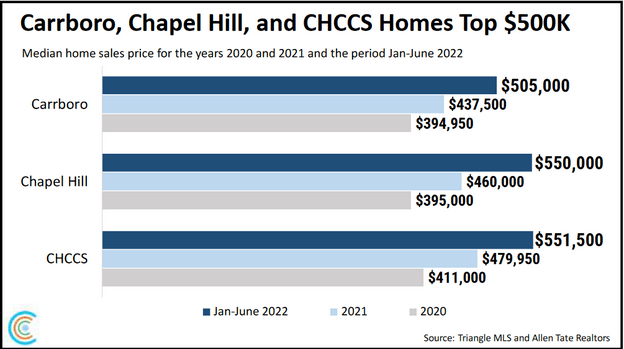
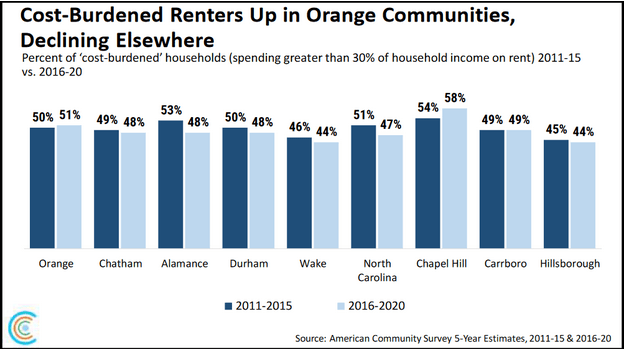
The DTH recently reported on professors getting priced out of Chapel Hill and Carrboro. A housing market assessment prepared for Chapel Hill’s TOD planning found that both owner-occupied housing and rental-occupied housing are constrained. Home prices are going up faster than salary increases, and higher than those in comparable geographies.
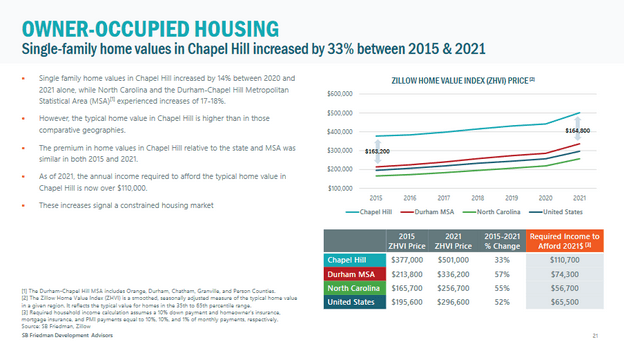
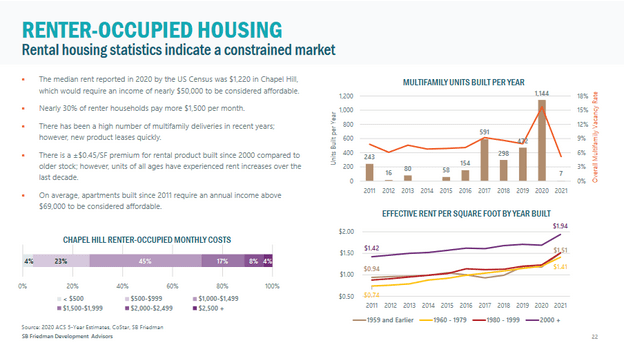
Many of Chapel Hill and Carrboro’s fiercest housing opponents purchased their homes decades ago — early in their careers or shortly after finishing graduate school. This is no longer possible. We simply do not build starter homes anymore.
When these opponents say they support a “mix of housing,” it actually means the following:
- A majority of market rate single family houses on large lots that become increasingly more expensive and exclusive
- A small number of legally-restricted “affordable” units, which are available if you enter a lottery and happen to get lucky
In contrast, taking a “do all the things” approach means creating diverse types of housing at a wider range of prices in every community. That’s good for ensuring that Chapel Hill and Carrboro have homes for small households like seniors and young couples, and for moderate-income working families.
We say yes to building more starter homes
In most of Chapel Hill, it is impossible to build anything other than apartment buildings (in some places) and single-family homes (in the majority of places.) This is an intentional and exclusionary policy choice that is currently baked into our land use management ordinance.
Starter homes are relatively small and affordable homes that enable young middle-class families to grow and build wealth. They might share walls — like duplexes which can house two families — or they might be a granny flat in an existing backyard.
Under NC state law, localities like Chapel Hill and Carrboro are pretty limited in their ability to require developers to build affordable units. (We see this asked on social media a lot: Why can’t you require developers to do X? The answer is usually because it’s not legal in North Carolina to do so.)
Chapel Hill requires mandatory inclusionary zoning, but very few units have been built. State and federal funds to build such housing is limited. Affordable housing is generally generated from developers who require a rezoning to build their project, so it’s a negotiating tactic that council can use — but it’s usually not generated from by-right projects.
But, given Chapel Hill’s high land prices and our aging housing stock, as time goes by our existing single-family homes are going to be replaced. If only single-family homes are allowed, they’ll be expensive single-family homes. A new duplex, triplex, or fourplex will necessarily be cheaper than a new single-family home because people aren’t willing to pay as much for a home with shared walls.
Will building more starter homes solve everything?
No, it’s not going to solve everything, and in fact, we probably won’t see many of these new types of housing built in any given year. But we think that, in conjunction with the town’s efforts to fund affordable housing and to make the affordable housing approval process more efficient, it’ll make an important difference.
We say yes to building more affordable housing
In Chapel Hill and Carrboro, we have a very small number of legally-restricted “affordable” units. The competition to get one is fierce, because people like living in neighborhoods near good schools, jobs, and amenities — and we don’t have enough. 38% of Chapel Hill households earn 60% or less of the area median income (AMI). There’s a current housing gap of over 5,000 homes.
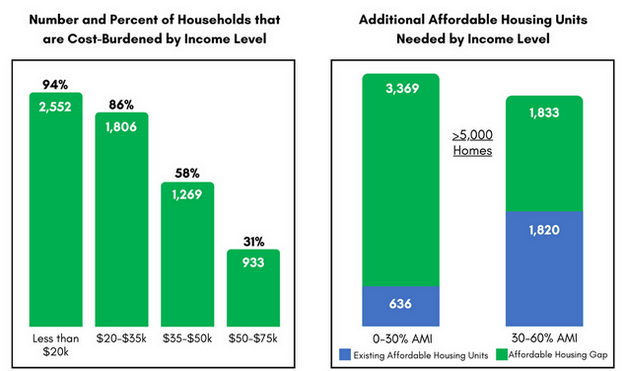
The Town of Chapel Hill maintains an excellent resource guide detailing emergency financial assistance, emergency housing assistance, home ownership opportunities and counseling, rental opportunities, home repairs and displacement assistance, legal housing assistance, and additional resources.
One of the biggest takeaways is this: There are more than 22,000 homes in Chapel Hill. Only one in 22 is permanently affordable.
In a perfect world, we would have enough government support to ensure that all people had access to safe, affordable housing regardless of income. But despite more than 50 years of public and private local investments in affordable housing, we have just 1,117 permanently affordable homes in Chapel Hill.
These homes are reserved for people at certain income levels, and most use a lottery system (literally) to determine who gets to rent or buy them. Homeowners who buy permanently affordable homes (like in Community Home Trust) get a traditional mortgage, but their home appreciation is limited, as the home prices can only rise if incomes do as well.
We have supported the town’s efforts to build more affordable housing, and we’re particularly excited by efforts to make the affordable housing approval process more efficient. That will make an important difference.
We say yes to preserving naturally occurring affordable housing
Chapel Hill currently has 3,717 naturally occurring affordable housing units. (The apartments that people in Chapel Hill protested in the early 1980s are now naturally-occurring affordable housing. As new apartments have come onto the market, the older ones have gotten cheaper.)
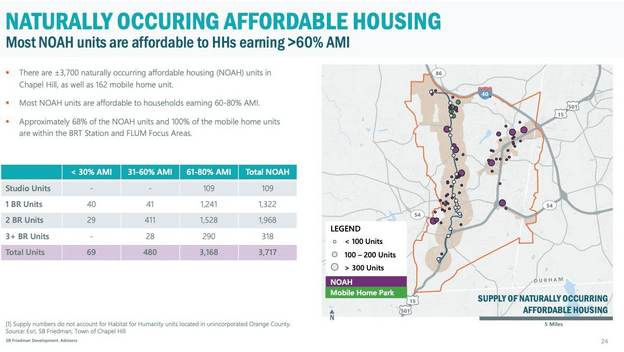
These naturally-occurring affordable rentals are affordable for a few reasons:
- They’re old. People pay more to live in new housing.
- They might have maintenance issues.
- The type of house (such as an aging apartment building) makes it unattractive to some.
- They might be in a sub-par location, such as near a flood zone.
We say yes to keeping long-time neighbors in their homes
There are a number of strategies that can be used to keep residents in their homes. We applaud the Neighborhood Retention Services offered by the Marian Cheek Jackson Center in Northside. Their strategies for home-owners include home repair services, property tax support, and workshops to keep long-term neighbors in their homes.
We need to worry about what happens to tear-downs
There are also houses that are 60-70 years old and in somewhat bad shape that are coming onto the market.
When small older homes are purchased, they are often torn down and replaced with much larger, much more expensive single family homes. This reduces our (already small) naturally-occurring affordable housing (NOAH) — a term that refers to existing older (and usually smaller) housing stock that’s affordable for modest-income households and renters.
We see this happening all over town – from The Oaks to downtown Carrboro.
The process of filtering – where as housing ages it becomes cheaper – is “contingent on allowing an ample supply of new housing, even when those new units are themselves more expensive than low and moderate income households can afford. The only reason that some communities have plenty of what gets called “naturally affordable” housing is that they made it relatively easy to build new housing and that in turn led housing to filter downward and become more affordable.”
To have more filtering, we need to build more housing.
That ALSO means we say yes to market-rate housing of all types
Healthy housing markets provide housing for all types and sizes of families for all stages of life. And houses of all types used to be fairly common — you can go to downtown Carrboro or Trinity Park in Durham and see great examples of quadplexes and apartments that add a great deal of design flair to the neighborhood.
But when there is not enough housing and we can’t build new types of housing, seniors, and especially those on fixed incomes, have nowhere to go. That means they remain in a home that may be too large for them and too costly to maintain. It also means they aren’t selling their home to a young family that needs more space.
Why don’t we have enough housing?
There are many reasons. Zoning regulations have created a shortage of homes in places people want to live. New construction has lagged behind demand. Higher income households can outbid lower income households for the limited housing stock that exists. Financing. Lots and lots of reasons.
A useful analogy – housing reform is like parallel deadbolts on a heavy door
Solving our housing crisis will require many reforms. We like the analogy that Daniel Herriages uses: that housing reform is “like a series of parallel deadbolts on a heavy door — like a bank safe.”
He writes, “Unlocking any one lock doesn’t allow the door to open. It’s only when they’re all unlocked that things can proceed. On our metaphorical door, only one of those deadbolts is labeled “single-family zoning.” The others have different names. “Built form regulations.” “Development fees.” “Development delays.” “Access to financing.” “Cost of construction.” “Skilled labor shortage.” “Development culture and support networks.”
The land prices in Chapel Hill mean that the new missing middle housing being proposed will not solve all of our housing problems. As one Facebook commenter recently wrote:
It is neither a panacea for affordable housing nor Armageddon. It’s one tool to incrementally increase the amount of housing in Chapel Hill. Speaking of incremental, take a look at this video, which explains the benefits of small-scale development. Sadly, the land prices here make it nearly impossible for this type of development, but that doesn’t mean that we shouldn’t allow someone to have a granny flat in their back yard, or build a duplex.
Housing abundance means building more affordable units AND more market-rate units for people at every stage of their lives
We say yes to more housing types that cater to people of all ages and household sizes. And yes to tenant protections (which are not currently allowed in the state of NC) And yes to thinking about other parts of housing reforms in parallel.
But doing absolutely nothing will continue to make Chapel Hill and Carrboro increasingly exclusive and harder to live in. We want a more robust, vibrant community and it starts with more housing.
Most objections to more housing are baseless
In any community, there are some people who don’t want to see more housing. For many of them, it’s just a matter of personal preference. They don’t like slightly taller buildings, they don’t like anyone sharing space with other people – even if it wouldn’t affect them – and they don’t like change. But rather than just admitting that, they make up reasons to oppose housing. Here are some we hear a lot:
- We don’t need more housing. We just need to end private development and real estate capital. We’re in a college town, so we have more than our fair share of folks who claim to be against capitalism. Fighting to stop housing from being built because we haven’t delivered on Marx’s promise (“From each according to their abilities, to each according to their needs”) is effectively giving into maintaining the status quo (which just happens to deliver a ton of unearned wealth to people lucky enough to already own homes here, including almost all of the people who argue against new housing). With a few exceptions (new McMansions, penthouse apartments), the new housing built in Chapel Hill is cheaper than older single-family homes on large lots. That’s because new homes, whether they’re apartments or townhomes, are smaller and built closer together than what was built in Chapel Hill in the past. And, over time, they’ll become even cheaper due to filtering. (See above).
- New housing would be great, but we don’t have the infrastructure. When people say this, they’re thinking of a few things—schools, power, water, and (really) traffic. In the past, Chapel Hill did have problems with school overcrowding, but changing demographics has meant that the school-age population is actually dropping. Likewise, water usage in Chapel Hill and Carrboro has been declining since OWASA implemented tiered conservation rates – meaning using more water costs more – and the reclaimed water plant was put online in 2009. There is ample evidence that our community will be able to meet drinking water demand. Everyone complains about traffic, but if you look at the data you’ll find that the traffic hasn’t changed much on most of our roads, anecdotes aside, and the growth that has occurred has happened largely due to people moving out to Chatham County to get housing because we don’t have enough in Chapel Hill and Carrboro. They use our main arterial roads to commute.
- We have to prioritize the environment. City planners and other experts in environmentally-responsible growth are clear about the best way to do that. We must change our zoning rules to allow for more density because low-density developments with single family homes produce a lot more greenhouse gas emissions than higher-density alternatives. We must add housing — duplexes, triplexes, condos — along transit corridors so that people can bike, bus, and walk to work instead of commuting an hour by car. We must build housing that is accessible and affordable for artists and teachers and town employees, so they don’t have to commute an hour to work. And we also need to change parking minimums and actively encourage more people to not use cars when going downtown. In other words, we need to see the forest for the trees.
We started this post by encouraging you to read Noah Smith’s excellent article on the playbook of leftists and liberals who work to block every proposed housing project that exists. We’ll end with a quote from his piece:
YIMBYs, on the other hand, recognize that the forces affecting cities change, and urban development has to change with them. Immigrants move in. People and companies move in and move out. Vast economic forces tug at cities, and it’s just not possible to stand athwart urban history yelling “Stop!”. No matter how much you try to restrain developers and companies and new arrivals, cities WILL change — they just won’t remain collections of idyllic little Jane Jacobs villages preserved in amber. And its up to us to shape that change into something equitable and inclusive instead of something chaotic and cruel.
Join us in building a more equitable and inclusive Carrboro and Chapel Hill.
Melody Kramer helped with this piece.